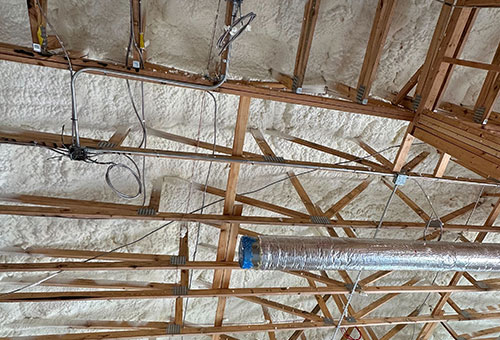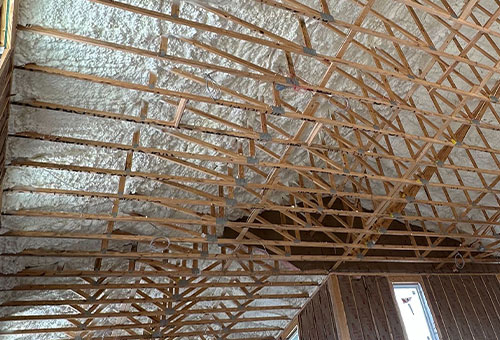The Problem Many Tennessee Homes Face
If you’ve ever opened your energy bills after an August heatwave or struggled to keep your bonus room above the garage comfortable, you’re not alone. In Middle Tennessee, hot, humid summers and moderate winters mean your home’s insulation is always on duty. The better your insulation performs, the more comfortable and efficient your home will be.
According to the U.S. Environmental Protection Agency (EPA), sealing and insulating your home can save you an average of 15% on your heating and cooling costs. In Tennessee, where our AC systems work overtime in summer, those savings can add up quickly over the long term.
What is Spray Foam Insulation?
Spray foam insulation is a high-performance insulation material applied on-site by a professional insulation contractor. It’s made by mixing two liquid components that expand into a foam when sprayed. It fills the cracks, gaps, and cavities of your attic, walls, or crawl space. Spray foam creates a continuous insulation layer that also acts as an air barrier. This is something traditional fiberglass insulation needs extra air sealing to achieve.
Types of Spray Foam
Open-cell spray foam
- Lighter, softer, and less dense
- Lower R-value per inch than closed-cell, but more affordable per volume
- Often used for interior applications like walls and attic floors

Closed-cell spray foam
- Dense, rigid, and offers higher R-value per inch (roughly R-6 to R-7 per inch)
- Functions as a moisture barrier when applied to sufficient thickness
- Adds structural strength and is ideal for crawl space walls, basements, or other areas where moisture resistance is needed
How Spray Foam is Installed
Spray foam is professionally applied using specialized equipment. The liquid mix is sprayed, expands to fill cavities, and then cures into a solid foam. Spray foam expands into tiny crevices that other types of insulation might miss. This ensures more complete coverage when installed. Since spray foam is “manufactured on site” in your home during installation, correct installation is critical. Experienced installers ensure proper mixing, temperature, and coverage.
Benefits of Spray Foam Insulation (Especially for Tennessee Homes)
There are many perks to choosing spray foam for your Murfreesboro-area home.
Superior Air Sealing
Spray foam insulates and air seals in one step. It helps keep the hot, humid summer air outside and warm air inside during winter. Foam insulation can fill the smallest cracks and cavities to create an effective air barrier that traditional insulation alone can’t provide. For your Tennessee home, that means fewer muggy drafts and less strain on your HVAC during our 90°F July days.
Energy Efficiency & Savings
Spray foam tackles both jobs of insulating and air sealing at once, unlike other forms of insulation. This means you can enjoy lower energy bills with less effort.
Higher R-Value per Inch
With closed-cell spray foam’s high R-value, you can achieve high insulation levels in small spaces or even 2×4 walls. This makes it ideal for tight spaces where thick fiberglass might not fit.
Moisture Control
Closed-cell foam helps resist water and acts as a vapor barrier. It helps prevent mold growth by keeping moisture out, which is critical in protecting your home’s structure over time in our humid, rainy climate. Tennessee’s building code does recognize closed-cell spray foam as an acceptable vapor retarder in certain applications.
Comfort & Home Environment
Spray foam reduces hot spots and cold spots throughout your home. Having a spray foamed attic will help keep your rooms more comfortable. It also helps improve your indoor air quality by reducing drafts and outdoor pollutants that want to come inside.
Longevity & Durability
Once cured, spray foam stays put for decades without losing its shape or insulating properties.
Drawbacks and Considerations of Spray Foam
Here some other important factors to explore when considering spray foam for your home.
Higher Upfront Investment
Spray foam is a greater upfront investment than fiberglass batts or cellulose insulation. The foam insulation cost does include both air sealing and insulation, which can offset some of the price. Over time your investment will be repaid via the energy savings you earn.
Professional Installation & Quality Control
Since spray foam is created on-site, it needs to be installed by skilled pros for the best results. This ensures proper mixing and installation, which are key for achieving proper curing and complete coverage. Remember to always hire a reputable, experienced contractor for the job.
Code Requirements (Fire Safety)
State and international building codes require spray foam to be protected with a thermal barrier like drywall for fire safety. It’s important to ensure spray foam is covered in living spaces. There are exceptions in some open areas, like attics and crawl spaces.
Not Easily Reversible
Once installed, spray foam adheres strongly and isn’t easily removed. It’s best to complete electrical or plumbing updates before installation.
Open-Cell vs. Closed-Cell Considerations
Open-cell foam may need an added vapor retarder in high-humidity locations like Tennessee. Closed-cell spray foam is the preferred choice for your crawl space and attic, while open-cell works well in interior walls.
Environmental Factors
Modern spray foams are free of ozone-depleting agents and contribute to lowering your home’s carbon footprint through energy efficiency. Some of them do contain petroleum-based ingredients such as polyurethane and isocyanate. Talk with your spray foam professional about the spray foam products they use.
Spray Foam vs. Traditional Insulation: How Does It Compare?
Thermal Performance
Experts agree all types of insulation perform well when correctly installed and air sealed. Where other insulations require manual installation plus separate air sealing, spray foam combines those steps into one process. This often delivers a more airtight building envelope.
Cost Comparison
Fiberglass insulation and cellulose insulation are a lower upfront investment but require additional air sealing for peak performance. Spray foam’s cost includes both insulation and air sealing in one. Plus, it remains solidly in place for many years.

Installation & Disruption
Batts and blown insulation can be DIY-friendly, but spray foam is not. Its installation process is much more involved and requires pros with specialized equipment. You will also need to vacate your home or building during and shortly after application. But spray foam is a one-time, long-term upgrade that doesn’t require much maintenance.
Air Sealing Needs
Fiberglass, mineral wool, and cellulose all need separate air sealing steps to achieve top performance. Spray foam builds sealing in from the start, making it easier to achieve a more airtight home.
Moisture/Pest Considerations
Fiberglass and cellulose can absorb moisture, possibly leading to mold if they get wet. Closed-cell spray foam resists water to help prevent mold and mildew. It also helps deter pests by preventing easy entry points and not providing a food source or nesting material.
Is Spray Foam Insulation Worth It for Tennessee Homeowners?
In Tennessee’s climate, spray foam delivers comfort, efficiency, and moisture control that can solve common problems like overheated bonus rooms or damp crawl spaces. While the initial investment is higher, the long-term benefits often justify the investment.
Spray foam is especially valuable for:
- Homes with significant air leakage.
- Moisture-prone spaces like basements and crawl spaces.
- New builds or major remodels.
- Homeowners planning to stay in their home for many years.
B&M is your Local Spray Foam Expert
B&M Insulation has been an active part of our Murfreesboro community since 1976. We’re committed to quality service and workmanship. We stand behind our spray foam installation and go above and beyond to meet your insulating needs. Contact us today for a free estimate and see why Middle Tennessee homeowners, builders, and contractors trust our team for expert home insulation solutions that perform for decades.
References
Department of Energy (DOE). “Sprayed-Foam and Foamed-In-Place Insulation.” Energy Saver – Types of Insulation, U.S. Department of Energy, energy.gov/energysaver/types-insulation. Accessed 23 July 2025. https://www.energy.gov/energysaver/types-insulation?nrg_redirect=307135
U.S. Department of Energy – Oak Ridge National Laboratory. Macmillan, Emma. “ORNL roof and attic design proves efficient in summer and winter.” ORNL News, 10 Sept. 2012, ornl.gov/news/ornl-roof-and-attic-design-proves-efficient-summer-and-winter. Accessed 23 July 2025. ornl.gov
Energy Star. “Seal and Insulate with ENERGY STAR – Why Seal and Insulate.” ENERGY STAR, U.S. Environmental Protection Agency, energystar.gov/saveathome/seal_insulate. Accessed 23 July 2025. energystar.gov
Insulation Institute (NAIMA). “Comparing Insulation Types.” Insulation Institute – I’m a Homeowner, North American Insulation Manufacturers Association, insulationinstitute.org/im-a-homeowner/about-insulation/insulation-types-comparing-insulation-options/. Accessed 23 July 2025. insulationinstitute.org
Insulation Institute (NAIMA). “Report: 89% of Homes Are Under Insulated.” Insulation Institute Blog, North American Insulation Manufacturers Association, insulationinstitute.org/report-89-of-homes-are-under-insulated/. Accessed 23 July 2025. insulationinstitute.org
National Rural Electric Cooperative Association. Boutelle, Miranda. “Insulation Made Easy.” The Tennessee Magazine, 1 Oct. 2022, tnmagazine.org/insulation-made-easy/. Accessed 23 July 2025. https://www.tnmagazine.org/insulation-made-easy/
Tennessee Climate Office. “Tennessee Climatology.” East Tennessee State University, 2023, etsu.edu/cas/geosciences/tn-climate/tn-climatology.php. Accessed 23 July 2025. etsu.edu
NAIMA Canada. “Comparing Insulation Options for Homeowners.” NAIMA Canada – For Homeowners, North American Insulation Manufacturers Assoc. (Canada), naimacanada.ca/for-homeowners/comparing-insulation-options/. Accessed 23 July 2025. naimacanada.ca
